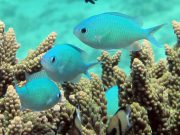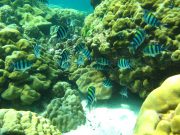Dykning med Damselfiskar
Lanta Marina Liv | Pomacentridae
Vi ser damselfiskar på alla dyk- och snorklingsplatser runt Koh Lanta. De är en av de vanligaste och mest förekommande familjerna på revet och finns vanligtvis på 2–15 meters djup, även om vissa arter kan hittas på djupare vatten.
Damselfiskar är små, sidledes sammantryckta fiskar som växer till en maximal längd på cirka 15 cm, men de flesta är vanligtvis mindre än 8 cm. Damselfiskarnas underfamiljer omfattar över 300 arter och är mycket nära besläktade med clownfiskar (anemonfiskar).
Många arter finns nära staghorn- och grenkoraller och söker skydd bland de skyddande grenarna av acropora-koraller när de hotas.
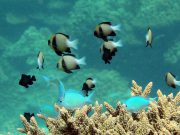
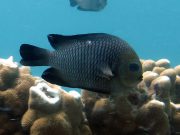
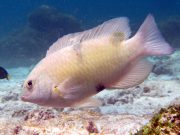
Färgen varierar kraftigt mellan olika arter, individer av samma art och inom en lokalitet för samma art.
Damselfiskar har utvecklats till tre undergrupper som kan definieras utifrån sina matvanor.
Den första gruppen livnär sig främst på små planktoniska kräftdjur. Den andra gruppen är betande arter som sköter och försvarar områden med trådalger, medan den tredje gruppen äter en kombination av zooplankton som finns i korallpolyper, små bentiska ryggradslösa djur och alger i varierande proportioner.
Damselfiskar är ofta territoriella och kan aggressivt försvara ett område med läckra alger, som de odlar precis som bönder, genom att skära bort vissa alger som de inte gillar och låta andra växa.
Honorna lämnar tillfälligt sina revir under lekperioden för att lägga sina ägg i hanarnas revir, där hanarna försvarar äggen tills larverna kläcks.
18 arter finns på denna sida:
- White Damselfish (Dischistodus perspicillatus)
- Black Damsel (Neoglyphidodon melas)
- Yellowtail Damsel (Neoglyphidodon nigroris)
- Three Spot Domino Damselfish (Dascyllus trimaculatus)
- Indian Damselfish (Dascyllus carneus)
- Blue Damsel (Pomacentrus pavo)
- Princess Damselfish (Pomacentrus vaiuli)
- Lemon Damsel (Pomacentrus moluccensis)
- Brackish Damsel (Pomacentrus taeniometopon)
- Similar Damsel (Pomacentrus similis)
- Speckled Damsel (Pomacentrus bankanensis)
- Whitetail Damselfish (Pomacentrus chrysurus)
- Indo-Pacific Sergeant (Abudefduf vaigiensis)
- Yellowtail Sergeant (Abudefduf notatus)
- Weber's Chromis (Chromis weberi)
- Indian Half-And-Half-Chromis (Chromis fieldi)
- Golden Damselfish (Amblyglyphidodon aureus)
- Jewel Damsel (Plectroglyphidodon lacrymatus)
White Damselfish
(Dischistodus perspicillatus)
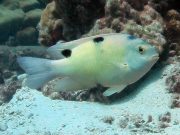
Adult White Damselfish @ Koh Haa
Adult White Damselfishes have a white body, with variable markings, including 2 or 3 black to dusky spots, saddles or bars on the forehead, mid-back, and rear back. Adults have many small dark speckled spots on the face.
Juveniles have a yellowish white body with two black bars, the first behind the head, and the second on the mid-body. In juveniles, the pectoral fins are yellow.
White Damselfish grow to 19 cm, however they are more commonly observed around 10 cm. This is mostly a solitary species, but may form groups. The diet includes algae.
Black Damsel
(Neoglyphidodon melas)
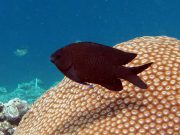
Young Adult Neoglyphidodon melas @ Koh Bida
Adult Black Damsels are completely black, with no distinctive markings.
Juveniles are a pale whitish blue with a yellow stripe from the snout to the rear dorsal fin.
The pelvic and anal fins of juveniles are bluish, with a black front margin and there are yellow borders on the tail fin.
The Black Damsel grows to 15 cm, but usually observed around 10 cm. Juveniles are encountered around branching Acropora corals and feed on plankton. As they grow, the diet includes soft coral polyps and later, the waste from Giant Clams (Tridacna).
Yellowtail Damsel
(Neoglyphidodon nigroris)
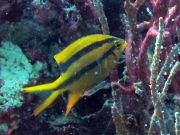
Juvenile Neoglyphidodon nigroris @ Koh Bida
The adult Yellowtail Damselfish has a brownish body, grading to yellow on the rear of the body, tail and adjacent fins. There is a dark bar on the gill cover and a black spot on the pectoral fin base.
Juveniles have a yellow body with a pair of black stripes from the snout to the rear dorsal fin base, and from the eye to the tail.
The Yellowtail Damselfish grows to 11 cm and feeds on algae, crustaceans, and plankton. Often solitary, or forms small, loose groups.
Three Spot Domino Damselfish
(Dascyllus trimaculatus)
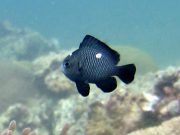
Juvenile Dascyllus trimaculatus @ Koh Haa
Juveniles have a black body with tree large white spots, one on each side of the body, and a third on the forehead. The spots will reduce in size as the fish grows, and all the fins are black.
The adult Three Spot Domino Damselfish has a dusky/dark grey body with black scale edges. The fins are dark, except the rear of the dorsal fin, which is translucent. Occasionally has a tinge of yellow or orange on the head and breast.
The Three Spot Domino Damselfish grows to 14 cm. Juveniles can often seen near and in anemones, sometimes mixing with anemonefish. Adults will usually form small groups.
Indian Damselfish
(Dascyllus carneus)
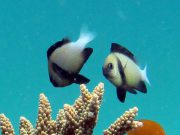
Dascyllus carneus @ Koh Haa
The Indian Damselfish, or Cloudy Dascyllus has a tan head and a whitish body with a diffuse black bar between. The head is sometimes accented with small blue spots.
The dorsal, pelvic and anal fins are black. Pectoral fins are translucent. The rear of the dorsal fin is translucent, as is the white tail fin. There may be a second black bar at the rear of the body.
The Indian Damselfish grows to 7 cm and feeds on plankton. This species forms small schools and shelters within the branches of Acropora corals.
Blue Damsel
(Pomacentrus pavo)
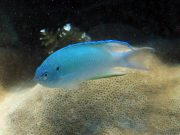
Pomacentrus pavo @ Koh Haa
The Blue Damsel, or Sapphire Damsel has a light blue to light green body with vertical dark streaks on the scales. There are scattered blue spots on the head and a dark 'ear' spot. The rear tail and anal fin can be yellowish.
The Blue Damsel grows to 11 cm and is often seen in groups. The diet includes zooplankton and algae.
Princess Damselfish
(Pomacentrus vaiuli)
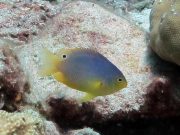
Pomacentrus vaiuli @ Koh Bida
The Princess Damselfish has several colour forms, with the body colour ranging from blue to orange or silvery.
This species has an eye-spot on the rear dorsal fin and may have a faint 'ear' spot above, and just forward of the pectoral fin base.
There may be faint blue lines extending from the snout onto the back and dorsal fin in some colour variations.
The Princess Damselfish grows to 10 cm. The diet includes algae and small invertebrates.
Usually seen solitary, but may form small, loose groups.
Lemon Damsel
(Pomacentrus moluccensis)
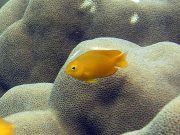
Pomacentrus moluccensis @ Koh Haa
The Lemon Damsel is a small, bright yellow fish with a fine dark margin on the anal fin, which makes this species easy to identify.
Usually, the Lemon Damsel also has a very small dark spot above the pectoral fin base and often a very small dark 'ear' spot.
The Lemon Damsel grows to 7 cm and is often observed living in small groups among the branches of acropora corals.
The diet consists mostly of algae and occasional planktonic invertebrates.
Brackish Damsel
(Pomacentrus taeniometopon)
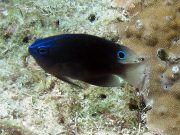
Pomacentrus taeniometopon @ Koh Haa
The Brackish Damsel has a dark brown to nearly black body with a pale tail. The upper head has neon blue markings and there is an ocellated spot on the rear dorsal fin.
The Brackish Damsel is a common species, growing to 12 cm, but is often observed much smaller than this.
Similar Damsel
(Pomacentrus similis)
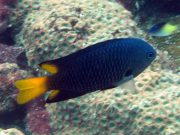
Pomacentrus similis @ Koh Haa
The Similar Damselfish has a deep blue body colour and is darker than most other blue-coloured damselfish. The scale margins are dark.
The tail is yellow and the rear dorsal and anal fins may also have a yellow margin.
The Similar Damselfish grows to 7 cm and is common at some of the dive sites around Koh Lanta, usually found around the reef edge, or over coral rubble areas.
As with other damselfishes, the eggs attach to the seabed or bottom substrate and are guarded and aerated by the males.
Speckled Damsel
(Pomacentrus bankanensis)

Pomacentrus bankanensis @ Koh Haa
The Speckled Damsel has a variable appearance, from an orange-brown body with blue lines from the snout, over the head to the back.
A common second variation is a completely yellow-brown body, with very faint blue lines on the head.
Both variations have an ocellated spot on the rear dorsal fin, a white tail, and a dark 'ear' spot.
The Speckled Damsel grows to 9 cm and is usually found over rubble and rocky areas, close to the reef.
The diet includes small crustaceans, pelagic invertebrates and algae.
Whitetail Damselfish
(Pomacentrus chrysurus)

Juvenile Pomacentrus chrysurus @ Koh Haa
The adult Whitetail Damselfish has a grey-brown body, often slightly lighter on the upper body and dorsal area.
The tail fin is white, and the upper part of the eye is orange.
Juvenile Whitetail Damselfish also have a grey body and white tail, but also have a thick orange stripe from the snout to the rear dorsal fin and upper body.
There is an ocellated spot on the rear dorsal fin.
The Whitetail Damselfish grows to 9 cm and is found in sandy areas close to coral reefs.
Feeds mostly on algae, with males guarding and aerating the eggs which attach to the substrate.
Indo-Pacific Sergeant
(Abudefduf vaigiensis)
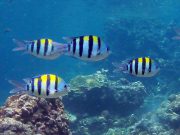
Abudefduf vaigiensis @ Koh Haa
The Indo-Pacific Sergeant has a grey body with five broad bluish black bars, including at the tail base.
This species often has a yellow back, and there is a dark spot at the rear of the dorsal fin. The forked tail fin has no markings.
Pacific Sergeant grows to 19 cm and feeds in small schools on zooplankton, algae and small invertebrates. Occasionally seen tending nests among rocks and coral ledges.
Yellowtail Sergeant
(Abudefduf notatus)
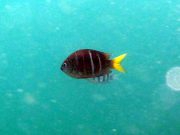
Abudefduf notatus @ Koh Haa
The Yellowtail Sergeant has a greyish-brown body with five vertical white bands on the body. The tail is yellow.
The Yellowtail Sergeant grows to 15 cm and sometimes forms schools, but can also be seen alone or in small groups, usually in shallow water.
Weber's Chromis
(Chromis weberi)
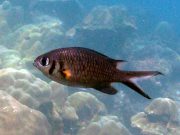
Chromis weberi @ Koh Haa
Weber's Chromis has a generally brown body colour, with black margins on the scales.
There is a dark brown vertical bar on the gill cover, and a second dark bar from the top edge of the gill cover to the pectoral fin base.
The Weber's Chromis is distinguished by the black tips on the tail fin lobes.
The Weber's Chromis grows to 12 cm. With males and females forming breeding pairs. Eggs laid by the female adhere to the bottom substrate and are aerated by the male until hatching.
Indian Half-And-Half-Chromis
(Chromis fieldi)
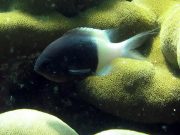
Chromis fieldi @ Koh Haa
The Indian Half-And-Half-Chromis has a dark brown to black head, forebody and mid body, with a white rear body and tail.
The Indian Half-And-Half-Chromis grows to 9 cm and is usually seen alone around the reef, close to the bottom, but may gather in larger schools above the reef.
The Indian Half-And-Half-Chromis (Chromis fieldi) commonly seen at the dive sites around Koh Lanta differs from the Red Sea variation (Chromis dimidiata), being identified as a new species by John E. Randall in 2012.
Golden Damselfish
(Amblyglyphidodon aureus)
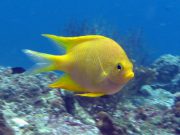
Amblyglyphidodon aureus @ Koh Haa
The Golden Damselfish is an almost entirely yellowish to gold colour, with possible dusky yellow patches on the side. The rear dorsal, rear anal and rear tail fin are translucent.
Golden Damselfish are often found over steep outer reef areas in habitats where there are abundant gorgonian and long sea-whip corals, usually in areas of medium to stronger currents.
The eggs are laid on the fan corals and sea whip corals and guarded by the males until hatching.
The Golden Damselfish grows to 13 cm and feeds on zooplankton.
Jewel Damsel
(Plectroglyphidodon lacrymatus)
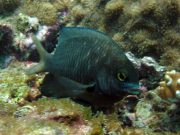
plectroglyphidodon lacrymatus @ Koh Bida
The Jewel Damsel has a dark brown body with black scale margins, fading to tan or white on the rear body and tail.
There are small scattered blue spots on the head and body.
The Jewel Damsel grows to 10 cm and is common at the dive sites around Koh Lanta.
Dykning med Damselfiskar runt Koh Lanta
Dykning och Snorkelutflykter
Om du vill ha en chans att se Damselfiskar på en av våra dagliga högsäsongs dykresor från Koh Lanta, skicka oss ett e-postmeddelande till info@diveandrelax.com.
Följ med på våra dykresor med speedboat under högsäsong till några av Thailands bästa dykplatser och njut av små grupper, korta restider och fokus på personlig service, säkerhet och nöje.
Är du ännu inte certifierad dykare? Lär dig att dyka på Koh Lanta med den 3-dagars SSI Open Water Diver-kursen.
Boka online och spara 10 % på dykresor och dykkurser på Koh Lanta.
Ta Reda på Mer
Guider för Marina Djur och Växter i Indo-Stilla Havet
- Allen, G., Steene, R., Humann, P., DeLoach, N. (2003) Reef Fish Identification, Tropical Pacific. Jacksonville, FL., USA: New World Publications, Inc., ISBN 1-878348-36-1.
- Humann, P., DeLoach, N., (2010) Reef Creature Identification, Tropical Pacific. Jacksonville, FL., USA: New World Publications Inc., ISBN 978-1-878348-44-9
- Debelius, H. (2013) Indian Ocean Reef Guide. Frankfurt, Germany: IKAN - Unterwasserarchiv, ISBN 978-3-939767-52-7.
- Debelius, H. (2004) Nudibranchs and Sea Snails, Indo-Pacific Field Guide. Frankfurt, Germany: IKAN - Unterwasserarchiv, ISBN 3-925919-51-1
- Erhardt, H., Knop, D. (2015) Corals Indo-Pacific Field Guide. Frankfurt, Germany: IKAN - Unterwasserarchiv, ISBN 3-925919-69-4.
- Veron J.E.N., Stafford-Smith M.G., Turak E. and DeVantier L.M. (2016). Corals of the World

